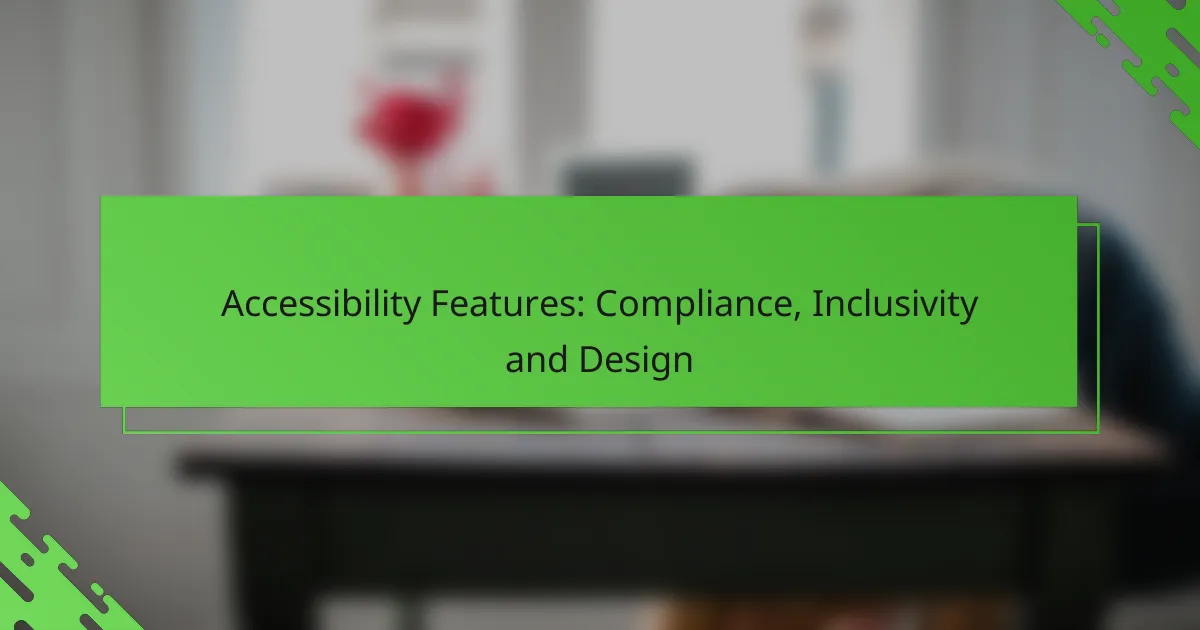Accessibility features are essential for ensuring that digital content is usable by everyone, including individuals with disabilities. By adhering to guidelines and regulations, organizations can promote inclusivity in their designs while meeting legal compliance. Implementing user-centered principles and integrating assistive technologies further enhances the accessibility of products and services, fostering a more equitable experience for all users.

What are the key accessibility features for compliance?
Key accessibility features for compliance include guidelines and regulations that ensure digital content is accessible to individuals with disabilities. These features help organizations meet legal requirements and promote inclusivity in their designs.
Web Content Accessibility Guidelines (WCAG)
The Web Content Accessibility Guidelines (WCAG) provide a comprehensive framework for making web content more accessible. These guidelines are organized into four principles: Perceivable, Operable, Understandable, and Robust (POUR). Each principle includes specific criteria that websites should meet to ensure accessibility for users with various disabilities.
To comply with WCAG, consider implementing features such as text alternatives for non-text content, keyboard navigability, and clear language. Regular testing with assistive technologies can help identify areas needing improvement.
Section 508 Compliance
Section 508 requires federal agencies in the United States to ensure their electronic and information technology is accessible to people with disabilities. This includes websites, software, and hardware. Compliance with Section 508 means meeting specific technical standards that align with WCAG.
Organizations should conduct regular audits of their digital content to ensure it meets Section 508 standards. This may involve training staff on accessibility best practices and using tools to evaluate compliance effectively.
Americans with Disabilities Act (ADA) Standards
The Americans with Disabilities Act (ADA) mandates that public accommodations, including websites, must be accessible to individuals with disabilities. While the ADA does not specify technical standards, it is often interpreted to align with WCAG guidelines.
To adhere to ADA standards, businesses should focus on creating an inclusive user experience. This can involve providing accessible customer service, ensuring website compatibility with screen readers, and offering alternative formats for content. Regularly updating accessibility practices is crucial to maintain compliance and avoid potential legal issues.

How can businesses implement inclusive design?
Businesses can implement inclusive design by focusing on user-centered principles, integrating assistive technologies, and conducting inclusive user testing. This approach ensures that products and services are accessible to a diverse range of users, promoting equity and usability for everyone.
User-Centered Design Principles
User-centered design principles prioritize the needs and preferences of end-users throughout the design process. This involves engaging with users from various backgrounds, including those with disabilities, to gather insights that inform design decisions.
Key steps include creating personas that represent different user types, conducting surveys or interviews, and iterating designs based on user feedback. Avoid assumptions about users’ needs; instead, validate ideas through direct user engagement.
Assistive Technology Integration
Integrating assistive technology into products enhances accessibility for individuals with disabilities. This can include screen readers, alternative input devices, and captioning tools that facilitate interaction with digital content.
When designing, consider compatibility with popular assistive technologies and ensure that interfaces are navigable using keyboard shortcuts or voice commands. Testing with assistive devices can reveal potential barriers and improve overall usability.
Inclusive User Testing
Inclusive user testing involves evaluating products with a diverse group of participants, including those with disabilities. This practice helps identify usability issues that may not be apparent in traditional testing scenarios.
To conduct effective inclusive testing, recruit participants from various demographics and abilities, and use a mix of qualitative and quantitative methods to gather feedback. Aim for a range of accessibility needs to ensure comprehensive insights, and be prepared to iterate on designs based on findings.

What are the benefits of accessibility features?
Accessibility features provide significant advantages by ensuring that digital content is usable by everyone, including individuals with disabilities. These benefits include improved user experience, a wider audience reach, and compliance with legal standards.
Enhanced User Experience
Accessibility features enhance user experience by making websites and applications easier to navigate and interact with. For example, screen readers help visually impaired users understand content, while keyboard navigation allows those with mobility impairments to access sites without a mouse.
Designing with accessibility in mind often leads to a cleaner, more intuitive interface for all users. Features like adjustable text size and high-contrast color schemes can improve readability and comfort for everyone, not just those with disabilities.
Broader Audience Reach
Implementing accessibility features allows businesses to reach a larger audience, including the estimated 15% of the global population living with some form of disability. By catering to this demographic, companies can tap into a significant market that is often overlooked.
Accessible design can also benefit aging populations, who may experience declining vision or dexterity. By ensuring that digital content is inclusive, organizations can attract and retain a diverse customer base, ultimately driving growth.
Legal Protection and Compliance
Accessibility features help organizations comply with legal standards such as the Americans with Disabilities Act (ADA) in the United States or the Equality Act in the UK. Non-compliance can lead to lawsuits and financial penalties, making adherence to these regulations crucial for businesses.
To ensure compliance, organizations should conduct regular accessibility audits and user testing with individuals who have disabilities. This proactive approach not only mitigates legal risks but also fosters a culture of inclusivity within the organization.

What are the costs associated with accessibility compliance?
The costs associated with accessibility compliance can vary significantly based on the size and complexity of the project. These expenses typically include initial implementation costs, ongoing maintenance expenses, and potential legal fees related to compliance issues.
Initial Implementation Costs
Initial implementation costs for accessibility compliance can range from a few thousand to tens of thousands of dollars, depending on the scope of the project. This includes expenses for auditing existing systems, redesigning user interfaces, and developing accessible content.
Investing in accessibility from the start can save money in the long run by reducing the need for extensive retrofitting. Consider hiring accessibility consultants or using specialized software tools to ensure compliance with standards like WCAG.
Ongoing Maintenance Expenses
Ongoing maintenance expenses are crucial for keeping accessibility features up to date. These costs may include regular audits, updates to content, and training for staff on accessibility best practices.
Budgeting for ongoing maintenance should account for periodic reviews, which can cost several hundred to a few thousand dollars annually, depending on the size of the organization. Regular updates help maintain compliance and improve user experience.
Potential Legal Fees
Potential legal fees can arise if an organization faces lawsuits or complaints related to accessibility compliance. Legal costs can vary widely, often ranging from a few thousand to hundreds of thousands of dollars, depending on the case’s complexity and duration.
To mitigate these risks, organizations should proactively address accessibility issues and stay informed about relevant regulations. Investing in compliance can reduce the likelihood of legal challenges and associated costs.

How to choose the right accessibility tools?
Selecting the right accessibility tools involves assessing your specific needs, the user demographics, and the compliance requirements relevant to your region. Consider tools that enhance usability for individuals with various disabilities while ensuring adherence to standards like the Web Content Accessibility Guidelines (WCAG).
Evaluation Criteria for Tools
When evaluating accessibility tools, focus on functionality, ease of use, and compatibility with existing systems. Look for features such as screen reader support, keyboard navigation, and customizable settings to meet diverse user needs.
Additionally, consider the tool’s compliance with local regulations, such as the Americans with Disabilities Act (ADA) in the U.S. or the Equality Act in the U.K. A tool that meets these standards can help avoid legal issues and enhance user experience.
Popular Accessibility Tools
Some widely used accessibility tools include screen readers like JAWS and NVDA, which assist visually impaired users by reading text aloud. Other popular options are keyboard navigation aids and color contrast checkers, which help ensure content is accessible to individuals with color blindness.
For web developers, tools like Axe and WAVE can automatically scan websites for accessibility issues, providing actionable insights to improve compliance and usability.
Vendor Comparison
When comparing vendors, assess their customer support, pricing models, and the breadth of features offered. Some vendors provide free tools with limited functionality, while others offer comprehensive solutions at a subscription cost.
For example, JAWS is a premium tool with extensive features, while NVDA is open-source and free, making it a good option for budget-conscious users. Evaluate these factors based on your specific needs and the size of your organization.

What are the emerging trends in accessibility design?
Emerging trends in accessibility design focus on integrating advanced technologies and innovative approaches to enhance user experience for individuals with disabilities. Key areas include the use of artificial intelligence, virtual reality, and inclusive design practices that prioritize usability for all.
AI and Machine Learning Applications
AI and machine learning are transforming accessibility by creating adaptive technologies that learn user preferences and behaviors. For instance, smart assistants can provide voice commands tailored to individual needs, improving navigation and interaction with devices.
Consider implementing AI-driven tools that analyze user data to suggest personalized accessibility features. This can include text-to-speech applications or predictive text that adapts to the user’s communication style. However, ensure that these tools comply with privacy regulations and ethical standards.
Virtual Reality Accessibility
Virtual reality (VR) is becoming a powerful medium for enhancing accessibility, allowing users to experience environments in ways that accommodate various disabilities. VR can simulate real-world scenarios for training and education, making them more inclusive.
When designing VR experiences, prioritize features like adjustable settings for visual and auditory elements, ensuring that users can customize their experience. Additionally, consider incorporating haptic feedback to aid users with visual impairments. Testing with diverse user groups is crucial to identify potential barriers and improve overall accessibility.


